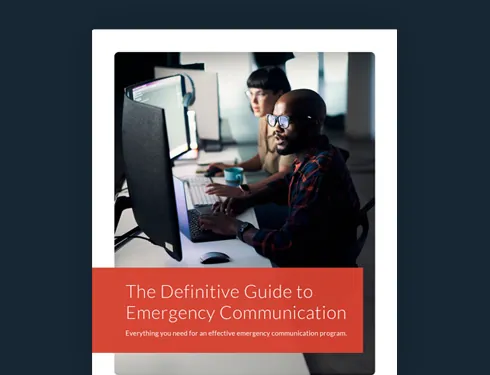
How AlertMedia Communicates With Employees During Emergencies
In this post, we discuss how AlertMedia leveraged emergency communication best practices during the recent winter storms in Texas.

Last month, historic winter storms ravaged the state of Texas and left millions without power, heat, and water for days. The resulting damages are expected to cost more than $20 billion, ensuring that the storm’s greater impact will be felt for months.
“We lost power on Sunday, and we didn’t get it back until the end of the week,” said Zach Balod, Senior Account Executive with AlertMedia. “While that in and of itself might not have been a problem, we then had three pipes burst, and flooding in our master bedroom, closet, and garage. We are currently living with a friend, and it will likely be at least 2-3 weeks before we can move back in.”
Several other employees at AlertMedia found themselves in similar situations, and as a company, we witnessed firsthand just how dangerous and disruptive severe weather events can be.
We feel grateful to work among a group of people so willing to step up in times of crisis, but we also learned a valuable lesson: no one is immune to emergencies, not even AlertMedia, a provider of software and services to other businesses to help them weather the storm (literally).
So, while the experience is still fresh, we thought it would be helpful to share how we leverage our own emergency communications system to keep our employees safe, informed, and connected throughout the course of the winter storms, and what we learned along the way.
The Definitive Guide to Emergency Communication
Activating Our Response Plan
Late Sunday evening, as entire neighborhoods began losing power amid increasing snowfall and rapid temperature drops, we immediately put our crisis management plan into action, following the necessary steps to ensure employee safety.
Step #1: Convene leadership
When faced with needing to make decisions fast, it’s important to get your leaders on the same page.
Our leadership team convened on a conference call, during which they discussed each of our options and best course of action knowing a large percentage of our team would be impacted as conditions worsened across the state. In addition to agreeing on how and when to communicate with employees throughout the storm, a cross-functional group of leaders also reviewed continuity plans for support teams knowing normal staffing levels would be impacted by prolonged power outages.
“It was such a relief to learn our leadership team put my safety as a priority and understood there was no way to do my job without having basic essentials,” said Jo Storrie, customer success manager at AlertMedia. “And those who did have power were so helpful, generous, and all around supportive.”
“Just knowing that someone at the company was worried about us meant a lot,” continued Zach Balod.
Step #2: Ensure employee contact information is up to date
Once our leadership team aligned on next steps, we made sure to review employee phone numbers and email addresses. One important but often overlooked use of an emergency communication system is maintaining accurate, up-to-date employee contact information, which is vital to an effective response in the event of a true emergency.
AlertMedia syncs with our Active Directory, which means even as employees come and go, the system keeps contacts automatically updated and accurate, so when it comes time to send notifications, we can rest easy knowing all employees will be kept informed of an event.
Step 3: Conduct daily wellness checks
During an emergency, crisis response leaders need the ability to both communicate out information and receive feedback back from employees. To get a better understanding of how many employees were without power, internet, and water, we sent out daily surveys every morning.
“"We wanted to make sure we not only understood who was available to continue to support our customers and who was facing crises of their own, but also to understand the safety status of our teammates and who might need help.””Sofia Covarrubias Customer Success Manager, AlertMedia
“Even though we had that Monday off in recognition of President’s Day, it became evident pretty early on that Austin was in a rough spot, with many places losing power overnight and waking up to subfreezing temperatures,” said Sofia Covarrubias, Customer Success Manager at AlertMedia. “That same day, AlertMedia began surveying all of its employees to understand who had power and who didn’t and then continued daily check-ins for the rest of that week. We wanted to make sure we not only understood who was available to continue to support our customers and who was facing crises of their own but also to understand the safety status of our teammates and who might need help.”
Tuesday morning, we learned that more than 40% of our workforce was without power, and those numbers continued to climb throughout the day and into the evening. Employee responses to the survey enabled us to more easily and quickly activate our back-up plans to minimize business disruptions to customers, but it also gave managers peace of mind to know their teammates were safe.
“The consistent check-ins made me feel so much safer knowing that other people were aware of my situation,” said Ro Duffy, Marketing Operations Manager at AlertMedia. “I knew the alerts were coming every morning around the same time, so I was able to conserve my phone battery so I’d be able to submit my response and not worry about needing to provide updates throughout the rest of the day.”
Step 4: Reiterate company leave policies and staffing plans
Severe weather may be unpredictable, but your company’s response to it shouldn’t be. That’s why we made sure early on to have a clearly defined policy in place that provides helpful details about our company’s procedures and what to do when bad weather—or any emergency—strikes.
Some questions our policy addresses include:
- What steps should employees take if they lose power or their internet connection?
- How will employees be notified of closures or reduced work hours?
- Will employee pay and benefits be affected for nonexempt employees if there are closings due to weather?
At the start of any emergency or crisis scenario, best practice suggests resharing your policy with all employees. Direct them to the most pertinent information should power outages or other incidents occur. Acknowledge any procedures you already have in place and outline steps employees should take to minimize impact to their daily work, and most importantly, reassure everyone that at the end of the day, their safety still matters most.
Lessons Learned
As we worked through our emergency preparedness playbook, three key lessons stood out to us as having been particularly vital to helping us continue business operations and stay in constant contact with employees and customers.
Lesson #1: Messaging templates accelerate communication
A crucial piece of planning for emergencies includes creating emergency notification message templates. We offer a variety of examples to our customers, so we simply updated the most relevant template to address the current situation. Having access to these templates not only saved us time and bandwidth, but it allowed us to focus on more pressing needs, including proactively getting ahead of additional risks like road safety and identifying locations of warming shelters. A great example of the templates we used can be found here.
Lesson #2: Multichannel communication is critical, especially when infrastructure fails
Due to the power outages, not every employee had access to a computer and internet, and many suffered from poor cell connectivity, so we couldn’t simply send one email or one text to communicate. Instead, we relied on multichannel communication, sending notifications out via email, phone, SMS text, and in-app push notifications. Corresponding on multiple platforms also makes employees more likely to see the message and that no one slips through the cracks.
“It was nice that I was able to get updates and respond via multiple channels,” said Jo Storrie. “If I didn’t want to use up a lot of data or power, I could simply respond quickly via text. Then, when I was able to charge my phone and computer, I could choose to get more updates within the application, including a map view that showed current outages.”
Lesson #3: Real-time analytics and reporting enables informed decision making
As we continued to receive updates from employees on whether or not they had power, we created a list with their corresponding status so that managers could easily and quickly see who may need assistance. When time is of the essence, streamlining the notification process allows you to communicate and act much more efficiently.
We also triaged the people who didn’t respond, so rather than placing the burden on managers to call every employee, we instead used the surveys to isolate non-responsive individuals and focused our efforts on the smaller group to confirm their safety.
“I was lucky to always have access to both my house and a friend’s home that had power, heat, and water, and I could alternate between both,” said Sofia Covarrubias. “But when I did lose power in the middle of the day on Wednesday, my director was able to quickly step in and help while I adjusted and relocated.”
Final Word
For many of our employees, they saw our mission statement come to life for the first time. We aim to save lives and minimize loss by facilitating timely, accurate, and relevant communications when an emergency situation threatens personal safety and business continuity, all of which we successfully managed a few weeks ago.
““Not a day went by where we were not contacted with appropriate updates, and asked to communicate our status and any needs"”Virginia Davies Receptionist, AlertMedia
“To have a company’s own employees be the actual recipients of the brilliance of their company’s own product, this is completely monumental, as its efficiency and effectiveness were used by every employee,” said Virginia Davies, receptionist at AlertMedia. “Not a day went by where we were not contacted with appropriate updates, and asked to communicate our status and any needs we might have been experiencing.”
In an ideal world, we’d never need to turn to our own system to communicate with employees, but if there’s anything we know for sure, it’s that you can’t predict when and where an emergency might strike. Seeing our system in action to protect our very own inspired many of us and will continue to serve as an example for how to best handle emergency communications.
“Overall, it was incredibly inspiring to see people doing whatever they could to help teammates,” said Chris Grebe, customer success manager at AlertMedia. “I joined this company because it felt like family, and the response showed me that my instinct was correct.”
We couldn’t agree more.



![How to Create an Inclement Weather Policy for Your Business [+ Template]](https://www.alertmedia.com/wp-content/uploads/2022/02/Blog-Inclement-Weather-v1.jpg)


